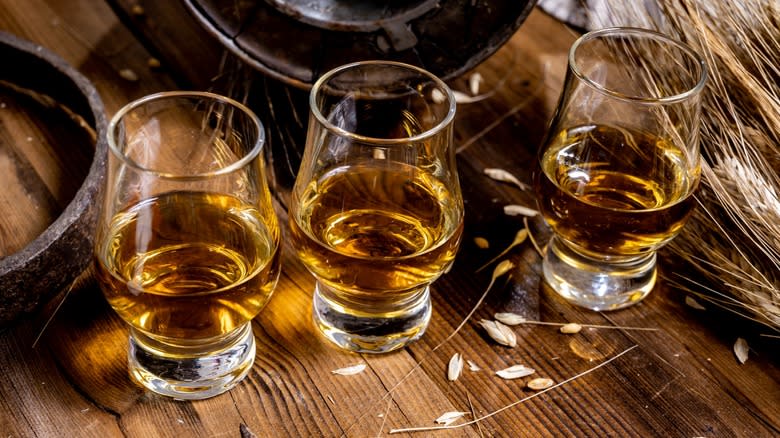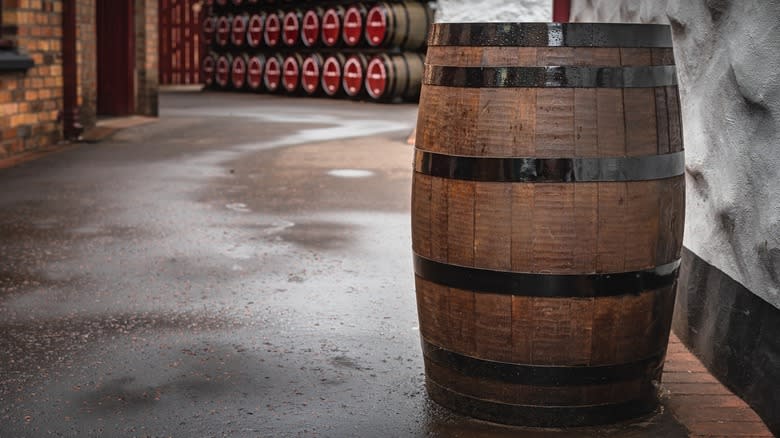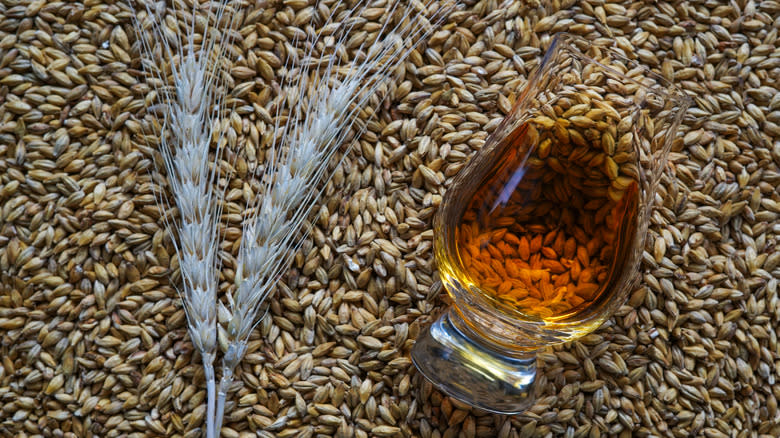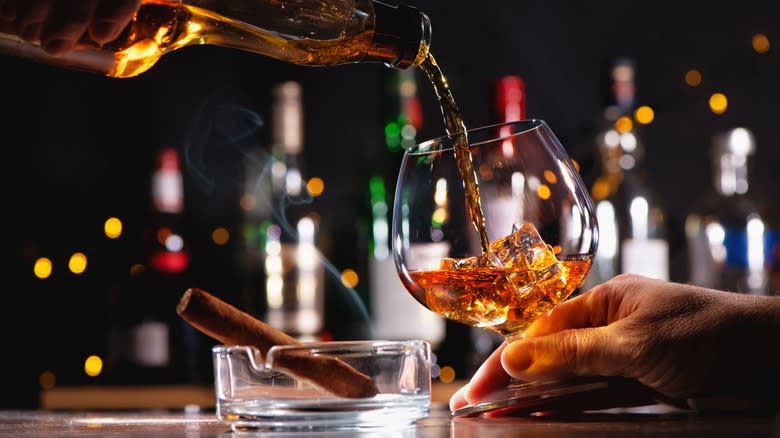Single Barrel Whiskey Vs Single Malt: What's The Difference?

Whiskey terminology can get confusing, especially since some of the terms sound so similar. "Single barrel whiskey" and "single malt whiskey" are two such phrases that can be difficult to suss out if you aren't already familiar with the whiskey-making process. Luckily, the difference is pretty straightforward and, once you understand what parts each phrase is referring to, you're unlikely to continue getting them confused.
The 30,000-foot view of the situation is that the term "single barrel" refers to a point in the process towards the end of production, whereas "single malt" refers to a point in the beginning. That will make more sense in a second but this is the broadest way to differentiate the two.
When making whiskey, the process goes like this: malting, mashing, fermentation, distillation, and finally, maturation. As you may have guessed, single malt refers to the first step called malting. Single barrel has to do with the maturation process, specifically the very end of maturation. Comparing the two is verging on comparing apples to oranges, but there are some key differences worth noting.
Read more: The 25 Best Bourbon Brands, Ranked
What Is Single Barrel Whiskey?

Single barrel whiskey is whiskey that comes from a single barrel. This isn't meant to be cheeky, it's just that straightforward. Whiskey that isn't labeled "single barrel" can be made the exact same way as a single barrel whiskey. You can even have a batch of whiskey where some are bottled and made as single barrels while other whiskeys in the batch are not. You see, during the maturation process, the whiskey is placed into barrels or casks to age for any number of years.
Depending on the location of the barrelhouse, the climate, where the specific barrel is within the building, and any number of other factors, the whiskey in each particular barrel is going to emerge from its years-long hibernation tasting somewhat different from its fellows despite being in the exact same batch. Normally, the master distiller will go around and taste a little from each barrel. Then, they will mix barrels together in such a way that the blended end product has a consistent flavor profile usually comparable to previous batches.
But by attaining consistency, you lose the individuality. Some barrels are different tasting than previous batches but in a good way. A distiller may choose to bottle these barrels on their own. Each barrel only has around 250 to 300 bottles worth of whiskey inside, so single barrels are often sold at a premium. They tend to be higher proof but the proof varies from bottle to bottle.
What Is Single Malt Whiskey?

Single malt whiskey is a bit more complicated. One way to look at it is to say that it is whiskey that's only made from malted barley, water, and yeast. Barley is the most common grain used, however, there are single malt whiskeys that use different grains. But it has to all be one kind of grain. You can't have a single malt whiskey made with malted barley and something else.
A less obvious requirement is that single malt whiskey has to be made by a single distillery. This is in the definition, but it means a lot less than you think it does. You can have a single malt whiskey that's been blended from three different single malt whiskies, so long as they were all made by the same distillery. Single malt is most commonly associated with scotch whisky, where the term is used to differentiate a product from blended scotch.
But single malt scotch is also often a blend. The difference is that blended scotch takes single malt whiskey and mixes it with grain alcohol, a cheaper and less time-consuming product to make compared to single malt, whereas a single malt scotch may blend different single malts from different batches, so long as they only mix with other single malts. Other countries make single malts as well, though. It's not exclusive to Scotland.
Bottles Of Single Barrel Whiskey Are Highly Variable

Going beyond the definitions of each term, how do single malt and single barrel whiskeys compare? The easiest way to demonstrate the fundamental difference between the two would not be to compare them to each other but to compare them to themselves. To be less cryptic, if you took 10 bottles of a single type of single malt whiskey and tried each of them you would very likely get the same flavors, same proof, et cetera.
That's not the case with single barrels. If you were to buy 10 bottles from the same exact barrel, they would absolutely taste the same. But if you were to go to the store and buy 10 bottles of a particular single barrel product and try each of them, you could end up with wildly different flavors. That's because each individual barrel has its own flavor profile and its own proof point.
Your chances of getting bottles from the exact same barrel are slim to none unless you're buying directly from the distillery and asking for it. For some, consistency is exactly what they're looking for. If a whiskey is good, then there's no problem. The novelty of each bottle having a slightly different flavor is part of the appeal of single barrel bottles, but whiskey connoisseurs are also looking for richer notes in their spirit that get muted out when blended. It's all about what you're into.
Single Malt Whiskey Is A Marketing Mirage

It's worth mentioning that "single barrel" is a very specific term that is relatively unambiguous. There's a barrel of whiskey and the whiskey inside doesn't mix with other barrels. If a bottle is labeled as "single barrel, barrel proof" that means it's entering the bottle exactly as it came out of the barrel. If it's not labeled "barrel proof," the whiskey is likely mixed with some water to reach the desired proof point. Other than that, with a single barrel what you get is what you see.
Single malt is not as easy to pin down from the customer's standpoint because the term has acquired meaning which it doesn't truly have. If you asked a handful of people what a single malt is, you would probably get at least one person describing a single malt as single barrel whiskey. Meaning, they think single malt means the same thing as single barrel. This could just be due to ignorance, but it's a wide enough problem (and one distilleries aren't quick to correct) that it verges on being misleading.
Single malt whiskies are seen as premium, and therefore they can sell at a premium. But within the genre of single malt, there is an enormous range in quality and characteristics. It looks nice on the bottle, it just doesn't actually tell you that much about what's inside. One thing you can tell is that whatever age is on the label indicates the youngest whiskey within the bottle.
Read the original article on Tasting Table.

